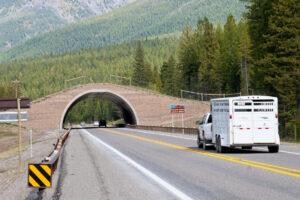
Resources from a first-of-its-kind road ecology study are now available on the web through the Western Transportation Institute at Montana State University (MSU). The Wildlife Vehicle Collision (WVC) Reduction and Habitat Connectivity project, a Transportation Pooled Fund Study, was developed through an international partnership of fourteen state departments of transportation (DOTs), Canadian transportation agencies, and the US Federal Highway Administration. The study includes twenty-seven authors, fourteen separate research projects, a Best Practices manual, and a final report synthesizing all findings.
The reports of the fourteen research projects can be explored on the webpage within four foci depending on area of interest: economics, ecology, design, and practice. Notably, the study includes a cost-benefit analysis of the most effective measures that reduce animal-vehicle collisions (AVCs). This report contains an update and expansion of a cost-benefit model addressing wildlife-vehicle collisions and associated highway mitigation measures that was originally calculated in 2007 and published in WTI’s 2008 US Congressional report, Wildlife-Vehicle Collision Reduction Study.
A portion of the study investigates two methods of managing animal crossing infrastructure costs. The first, led by WTI Researcher Matt Bell, is by incorporating fiber-reinforced polymers (FRPs), strong but lightweight materials that have a long service life, highly customizable shape, are inexpensive to maintain, and can be manufactured from recycled plastics and bio-based materials. The second is a cost-benefit analysis that investigates the true monetary losses of an AVC by extending consideration not only to huntable game animals, but to small mammals/reptiles/amphibians, free ranging livestock, and feral donkeys and horses. This novel approach recalculates the money saved by avoiding an AVC as a human and as an animal, revealing that on many roadways it is significantly cheaper to invest in animal crossing infrastructure than to pay for AVCs over the course of a structure’s life.

“Almost everyone agrees on the human safety and biological conservation benefits of AVC mitigation, but the updated cost-benefit model shows that the more we learn and the more the model expands, the more economically feasible mitigation measures become. There are lots of green lights for implementation,” noted WTI Senior Ecologist and the study’s Principal Investigator, Dr. Marcel Huijser. Additionally, while the incorporation of new mitigation technologies like FRP wildlife crossings or raised road concepts may be high, added Nova Simpson, a champion of the study and the Northern Nevada Biological Supervisor & Large Mammal Mitigation Specialist for Nevada DOT, “the long-term benefits will make these structures attainable and less costly, opening up habitat across the landscape.”
Led by Dr. Huijser and a diverse team of ecologists, engineers, and economists, the study is jointly managed by Nevada DOT and maintained by 12 federal, state, provincial, and non-profit partners from the United States and Canada. They have collectively invested more than one million dollars, making this project the largest wildlife-focused highway safety study in North America to date. As such, WTI will maintain a website for the TPF-5(538) study results and outreach. The public, as well as state and federal roadway managers, will have long-term access to all products related to this project, including future presentations and peer reviewed articles as they are published. With the recent passing of the Infrastructure Investment and Jobs Act of 2021 and its provision to allocate $350 million over five years to fund a pilot wildlife crossing program in the U.S., content from this study could help inform state DOTs as they make decisions for their roads.
“Working with WTI has been an absolute pleasure,” commented Simpson. “WTI’s team includes some of the best road ecologists in the world, the sponsors of this project are so pleased with the results, and we are eager to share them with the transportation community and its stakeholders.”
To view the research findings and keep up with future resources, please visit http://tpf-5-358-wvc-study.org.
